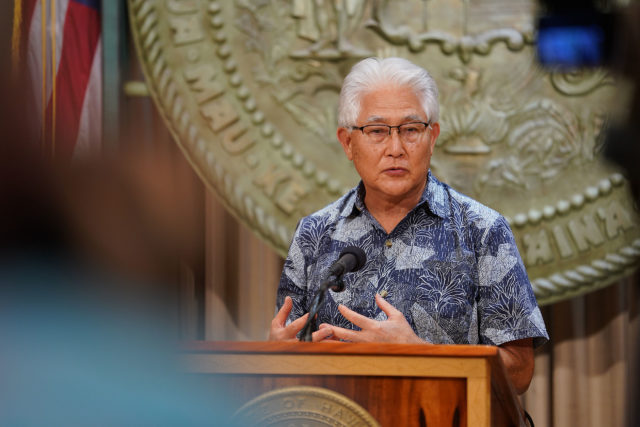As Hawaii’s business and political leaders craft a short-term plan to reopen Hawaii’s shuttered economy, Gov. David Ige’s appointee to help oversee the state’s recovery, Alan Oshima, is also looking at the longer term.
The former chief executive of Hawaiian Electric Co., Oshima stepped in on April 8 as Ige’s direct report heading Hawaii’s economic recovery. Established by proclamation, Oshima’s new job has a lofty title: Hawaii Economic and Community Recovery and Resiliency Navigator.

It’s part of Ige’s office, and Oshima is a volunteer, on loan from Hawaiian Electric, where he’s still paid as senior executive advisor. Oshima said an ethical firewall has been set up to prevent conflicts of interest.
Although the proclamation installing Oshima provides little detail on powers and duties, it does say the navigator is to “coordinate, direct and implement a collaborative statewide plan for economic and community recovery and resiliency.”
In an interview, Oshima said part of his role is to coordinate with others already working to resolve both the immediate and longer-term issues facing Hawaii.
The other groups include the state’s COVID-19 response team and the House Select Committee on COVID-19 Economic and Financial Preparedness, whose members include Peter Ingram, chief executive of Hawaiian Airlines, Dr. Mark Mugiishi, chief executive of Hawaii Medical Service Association, and Chris Tatum, President & CEO, Hawaii Tourism Authority.
“He’ll be a good addition,” said Scott Saiki, the Hawaii House speaker who co-chairs the House Select Committee with Peter Ho, chairman and chief executive of Bank of Hawaii. “It’s going to take a lot of people working together to get through this.”

And it will likely take considerable skill for Oshima to craft an economic development plan people can agree on.
That would have seemed difficult in even the best of times, such as just two months ago, when Hawaii’s tourism economy was booming and the unemployment rate was hovering just above 2%. At the time, business and political leaders had come together to begin tackling pervasive social and economic problems, including an economy marked by low wages and the nation’s highest cost of living.
Want to know more about COVID-19 in Hawaii? Here’s where to get the latest data on cases and transmission.

Still, development projects like the Thirty Meter Telescope planned for Mauna Kea and a wind farm in Kahuku were prompting protests that were slowing or stalling the projects. It remains to be seen whether such protests will continue with the same vigor now that the tourism economy is shut down and some 237,000 residents are out of work.
Oshima indicated he’s not going to push an agenda but rather listen to what people say they want. Even though Ige has suspended government transparency measures like the state’s open meeting and public records laws, the governor’s proclamation expresses lofty goals concerning public participation in crafting the economic plan. It’s intended to be based on engaging stakeholders, coordinating efforts and collecting input, among other things.
To that end, Oshima said public input, including comments and ideas as well as data that can be used to drive analyses, will be put on a website being set up by Ige’s office.
In the shorter term, Oshima said, he agrees generally with a plan that’s been articulated by economists with the , which was presented on Monday to the House Select Committee.
Reopening Our Social Fabric
It includes having robust systems in place for screening, testing, contact tracing and isolating people who test positive before the economy opens in phases, with businesses geared toward locals opening before the tourism industry comes back. But the reopening means more than just opening businesses, he said.
“It’s not just reopening our state to tourism,” he said. “It’s reopening our social fabric, our economy.”
“Whenever there’s this kind of disruption, people really have to look inside and make some choices.” — Alan Oshima
New rules concerning social distancing might need to be in place, he said. And certain things may need to be institutionalized.
“What are the new rules?” he said. “It’s not just turning a light switch.”
Business models might have to change.
“Whenever there’s this kind of disruption, people really have to look inside and make some choices,” he said.
For example, he said, the improved air quality resulting from fewer cars on the road and the widespread practice of working from home could lead to more people sharing rides and companies letting more people work remotely. Oshima tempered his outlook on remote work, however, saying both Google and IBM had discovered benefits of having workers share space after giving remote work a go recently.
“There are going to be different models,” he said. “It’s not all going to be black and white.”
In the end, he said, the goal is to create a plan that will make rational decisions. But he said, there will almost certainly be some who are not happy.
“Not everyone is going to get their way,” he said.
Want more information on COVID-19 in Hawaii? You can read all of Civil Beat’s coronavirus coverage, find answers to frequently asked questions or sign up for email newsletter updates — all for free.
 Sign up for our FREE morning newsletter and face each day more informed.
Sign up for our FREE morning newsletter and face each day more informed.
Support Independent, Unbiased News
Civil Beat is a nonprofit, reader-supported newsroom based in ±á˛ą·É˛ąľ±Ę»ľ±. When you give, your donation is combined with gifts from thousands of your fellow readers, and together you help power the strongest team of investigative journalists in the state.
About the Author
-
 Stewart Yerton is the senior business writer for ĚěĂŔĘÓƵ. You can reach him at syerton@civilbeat.org.
Stewart Yerton is the senior business writer for ĚěĂŔĘÓƵ. You can reach him at syerton@civilbeat.org.

